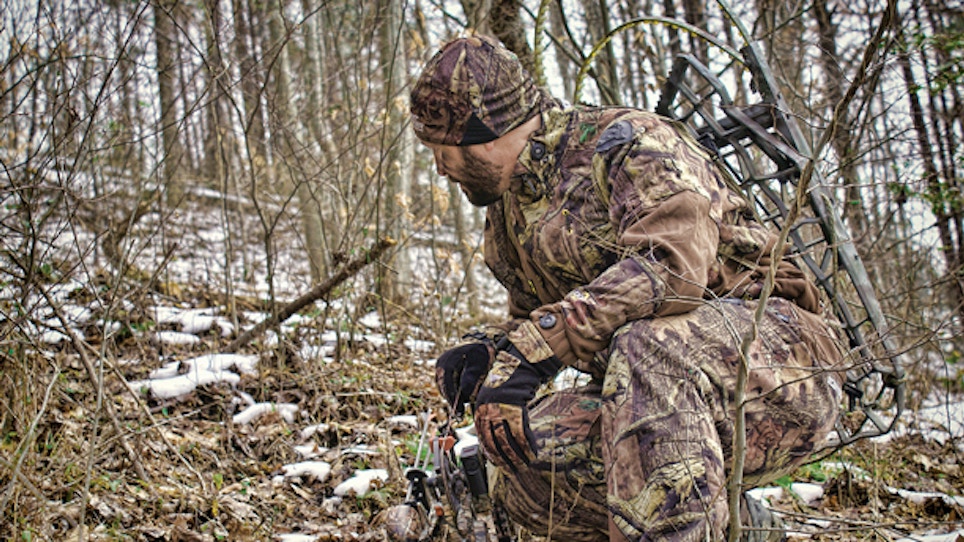The one thing that draws us bowhunters into the sport is getting close enough to our quarry to get the job done. This can be accomplished by either going to the deer or by bringing the deer to you. Here are six tactics to consider as you start your hunting season.
The Element Of Surprise
If you want to consistently tag a mature whitetail buck the word “surprise” should be the cornerstone of your hunting-strategy vocabulary. Everything you do should be done with one goal in mind – never let the deer know they are being hunted.
Reaching that goal, however, takes some effort. From post-season scouting to hanging treestands for different wind conditions, staying one step ahead of the deer in your area isn’t easy. And if you can’t pull it off with the general deer population, forget about fooling a mature buck.
The Ins and Outs
When it comes to the element of surprise, perhaps the one area that causes the most problems for bowhunters is entry and exit routes. Most hunters are going to take the path of least resistance when it comes to reaching their stand sites. The problem is this places them in the same path as the deer. This is true not only in tough mountain terrain but in easily accessible areas that hold food plots and other agriculture as well.
Sometimes it isn’t tough terrain that deters bowhunters. Sometimes it is simply the time required to avoid bumping deer. The best approach, no matter where you hunt, is to choose your entry and exit routes with the element of surprise as the deciding factor. This might mean you have to set the alarm a little earlier. It might mean you have to adopt an offseason workout plan to handle the workload. Whatever the dues are, pay them.
Funnel That Big Buck
Looking at a large tract of land and choosing that one tree a monster buck is going to walk past can be intimidating. However, when you start breaking things down to areas a mature buck is likely to occupy and areas he is least likely to occupy, the odds get better. But there’s more.
After finding the right area, the next step is finding the right tree. You can do this by locating funnels that will drive deer past your stand. The very best funnels leave the deer no choice but to walk past your stand.
Some natural funnels include ridge-top saddles, creek crossings, erosion ditches, logging roads in mountain country, and anywhere steep and gradual terrains collide. Deer will typically use these funnels to get from point A to point B with minimal effort. Good cover can also add to the attractiveness of a funnel. Mature bucks especially like heavy cover to conceal their movement.
Fake It
The right area and the right tree might not always be enough. Sometimes you need that little extra something to bring your dream buck in close enough for the shot. This is where the use of mock scrapes can come into play.
Popular media suggests that mock scrapes should be made in the weeks leading up to breeding. And while that is good advice, I have had equally good results starting them in July. Yes, I have created mock scrape locations in the middle of summer. Why? Because bucks are running in bachelor groups at this time and they pretty much know who’s who. Introducing an intruder via your mock scrape entices a mature buck to find the one who dares move in on his turf. It’s been my experience that he will continue to do so well after the bachelor group breaks up.
Like He’s On A Rope
Mock scrapes aren’t the only way scents can be utilized. They are also great when walking into your hunting area. Sometimes I leave a trail of hot-doe scent as I walk to my treestand. Doing so not only helps cover my own scent, but also gives any buck that crosses my trail a reason to turn and follow me.
Just be sure to freshen it often – I stop every 50 yards or so and add a few drops to my boots or drag rag in order to maintain the odor’s strength as I get closer to my stand. This prevents a buck from hitting my scent trail and heading in the wrong direction because the scent got weaker as I went along.
Also, when I’m laying down a scent trail I avoid walking directly to my stand. Instead, I walk to one side or the other of it, usually about 20 yards away. If a buck comes in with his nose to the ground, I want him walking slightly away from my tree right into my shooting “sweet spot.”
She’s The One
When everything else fails – maybe he missed the scent stream you laid down or the natural funnel he was supposed to walk in on – a decoy can really help pick up the slack.
If your decoy is positioned correctly and it’s the right time of year, a wary buck won’t be able to resist the temptation of love or the prospect of a fight. Decoys are best suited for the tail end of the pre-rut and the peak of the rut. During this time, bucks tend to let their guard down in their quest to breed. A decoy can help put a big buck, one that might otherwise walk on by, right in your lap. Just be sure to place it in a high-traffic area with a good shooting tree and favorable wind direction.






